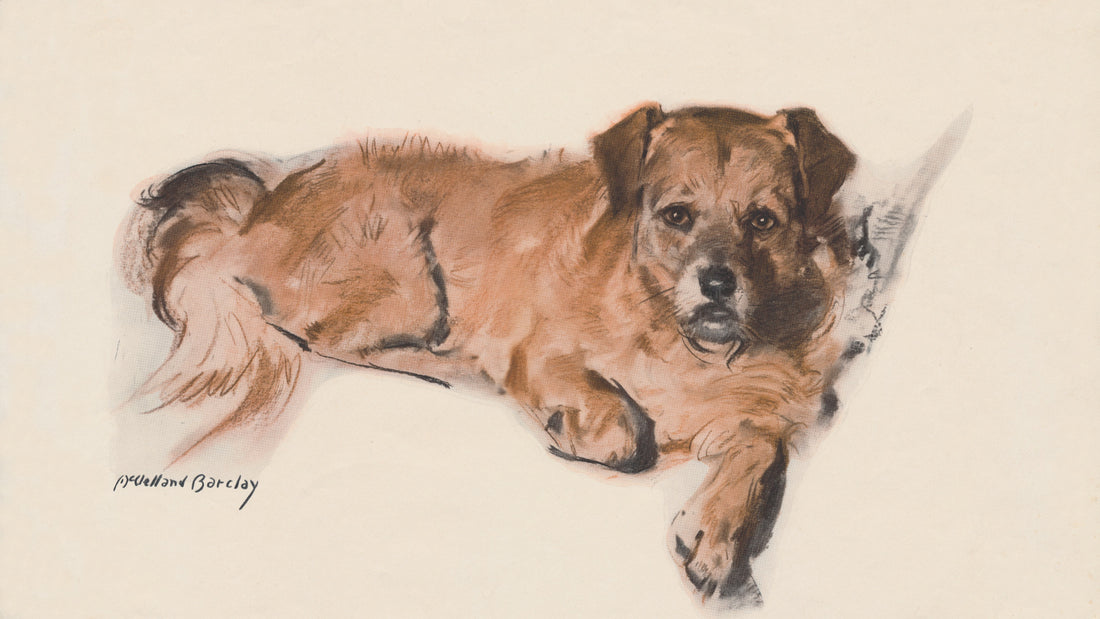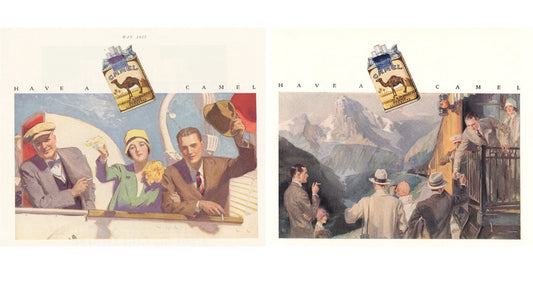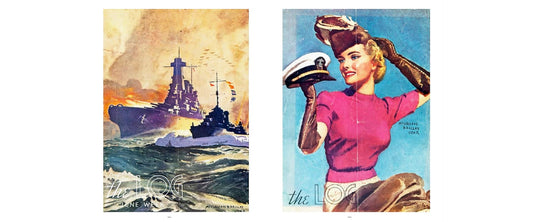
The Borzoi and other Art Deco dogs in McClelland Barclay works
Share
 Are you a dog lover like me? I know McClelland Barclay was too. Even though he was well known as a “pretty girl” artist in the Art Deco era, he often depicted a Borzoi and other dogs alongside the people in his commercial and editorial paintings, in metal works, and even jewellery!
Are you a dog lover like me? I know McClelland Barclay was too. Even though he was well known as a “pretty girl” artist in the Art Deco era, he often depicted a Borzoi and other dogs alongside the people in his commercial and editorial paintings, in metal works, and even jewellery!
And, I know he was a dog owner like myself.
Dogs and life companions
Among his personal papers, which I used in researching my biography of the artist, I found a personal greeting card from Hélène and McClelland Barclay with an adorable and aptly-named “Charcoal” Scottie dog peeking out. I also found photos of Mac and Mardee Hoff, his last love, probably taken at the beach in the Hamptons, New York in the late 1930s. He cuddles a black Scottie dog, she wraps her arms around a big fluffy Afghan on her lap.
 |
 |
 |
Canines, charities and fashion statements
McClelland Barclay also lent his artistic talent for canine charities, including a painting of “Pat”, for a 1934 Humane Society of New York fundraiser (featured image, and in photo below left). Lt. Cmdr. Barclay, U.S.N.R., also painted a “Dogs for Defense” poster in 1942 shown in photo below right, with Mardee Hoff, Bodo (a spaniel) and Mickey (a terrier). Dogs for Defense was a national organization made up of dog owners, fanciers and trainers, supplying thousands of trained sentry dogs for the U.S. Army in WWII.


Photo (left) caption: "New York City-McClelland Barclay, famous artist forsakes the drawing of beautiful girls to draw "Pat." mascot of the Humane Society of New York for a charity poster, which will be auctioned off at their bridge luncheon at the Ritz Carlton, Wednesday, March 21st, 1934. - Wide World Photo via Enchantment Ink, p. 155.
Look more closely at many lifestyle scenes Mac painted for advertisers and magazines, and you will see many different dogs in supporting roles. According to the American Kennel Club, at least six of the top ten dog breeds in the 1920s, can be found in McClelland Barclay’s illustrations: German Shepherd, Boston Terrier, Pekingese, Fox Terrier, Collie, and Spaniel.
 |
 |
L to R: Redbook cover with a Fox Terrier, May 1932; A Jack Russell looks on as a boy does a headstand, Black Cat hosiery ad (1919); a young girl holds a Boston Terrier in her lap while a boy plays marbles, Buster Brown shoes ad 1920s; the cover of January 1933 Pictorial Review has a baby with a plaid dog toy.
Borzoi - the Art Deco Dog and Divas
And then there is the Borzoi, the high fashion canine breed of the era. Borzois are featured in some of Mac’s most iconic ads for GM's Fisher Body Company. The tall, lean look of the breed aligned with the streamline aesthetic of the Art Deco era. McClelland Barclay’s illustrations in the 1920s and early 30s often included a woman with a regal Borzoi at her side.
The black and white Fisher Bodies ad in the Saturday Evening Post from September, 1923 shows a woman with bobbed hair in the new style of drop-waist dress holding a Borzoi. The fashion, the pose and elegant profiles of woman and dog give the scene an idealized early Art Deco look. Quite a contrast from the elaborate Edwardian-era flourishes framing it. Only a wheel (and the copy) indicates the ad was about automobiles.
No doubt Mac would have been aware the continued popularity of Borzoi dogs was helped by Hollywood’s silent movie stars like Greta Garbo and Mae West, who posed with them in publicity photos for their films in the late 1920s to early 30s.
By the time colour printing quality had improved, Barclay’s full colour magazine covers and advertising art also evolved in style. No backgrounds, or only a hint of the season’s falling leaves or blowing scarf swirl around women wearing more curvy but still elongated fashion silhouettes. And their beautiful Borzoi dogs were faithfully by their side.
 |
 |
 |
L to R: Fisher Bodies ad, Saturday Evening Post, September 1923; Pictorial Review cover, October 1932; Fisher Body ad illustration only, Country Gentleman, March 1929.
German Shepherds and Buddy, the Seeing Eye Dog
Speaking of movie stars, Rin Tin Tin was a German Shepherd rescued in France by an American GI in WWI. He became America’s most famous dog, starring in 27 films from 1922 to 1931. Likely helping this breed become the most popular during that period.
McClelland Barclay, not only painted German Shepherds into ad works, he also immortalized the first trained seeing eye dog, a German Shepherd named Buddy, in a pair of bronze plated bookends.

L: Buddy the original seeing-eye dog bronze plated bookends; R: bronze plated mini Pekingese statuette.
Buddy was trained in Switzerland with a blind man, Morris Frank, who proved Buddy’s capabilities in dramatic fashion:
On June 11, 1928, having completed instruction in Switzerland, he arrived in New York City, proving the ability of his dog, Buddy, by navigating a dangerous street crossing before throngs of news reporters. - SeeingEye.org
I speculate McClelland Barclay, dog lover, WWI artist and U.S. Naval Reservist, working from his Fifth Avenue studio at the time, may have been there to watch the spectacle. You can find metal art sculpture products of different dog breeds, like the cute little pekingese statuette (above right) in my decor collection made in the 1930s by McClelland Barclay Art Products, Inc. See the Buddy bronze-plated bookends new in the shop, while the spaniel pencil sharpener and Scottie dog ink blotter are coming soon!

L to R: Collectors and dog lovers will adore the bronze-plated spaniel sitting atop a pencil sharpener; a Scottie on an ink blotter, both made in the 1930s by McClelland Barclay Art Products, Inc. and signed with the artist's mark. A rare pair of retriever dogs are the subject of a sterling silver hunting dogs brooch from Barclay’s jewellery works made by Rice-Weiner Company between 1938-1942.
By their dogs ye shall know them
“By their DOGS ye shall know them” reads the copy on the July-August page of the 1928 Life’s Dog Calendar, shown below. McClelland Barclay’s illustration of just below the knees of two ladies, one with a fox terrier, the other with a pekingese, tells you a lot about the women walking them.

It may be that Mac included dogs in his illustrations to humanize his subjects and attract attention.
The terrier's leash wrapped around the woman in this 1935 ad for Humming Bird hosiery (below left) is a great foil for showing a shapely leg and the product. The young girl’s arm around her Great Dane in a 1925 Fisher Bodies ad (centre) gives comfort as she waves goodbye to those departing. Right, a pair of attentive white terriers beside the couple mapping out their road trip in the 1929 Texaco ad conveys companionship and adventure.
 |
 |
 |
I’m not sure if advertiser’s or magazine editors asked McClelland to include dogs as part of the social tableaux he painted for them. But these examples and many other works exhibit the artist’s skill at capturing pet personalities and his personal affection for dogs.






